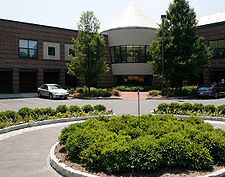
Healthcare real estate
Encyclopedia



Niche market
A niche market is the subset of the market on which a specific product is focusing; therefore the market niche defines the specific product features aimed at satisfying specific market needs, as well as the price range, production quality and the demographics that is intended to impact...
within the larger real estate market. Healthcare real estate or "Medical real estate" describes buildings, offices, and campuses leased to members or organizations within the healthcare community, but owned and operated by third party groups. There is a rising trend among hospitals, health care systems, and medical practitioners to embrace third party ownership and management of real estate
Real estate
In general use, esp. North American, 'real estate' is taken to mean "Property consisting of land and the buildings on it, along with its natural resources such as crops, minerals, or water; immovable property of this nature; an interest vested in this; an item of real property; buildings or...
. By using third party developers, they can preserve their capital resources for acute care needs and focus their attention on helping people, while passing on responsibility of building regulation and maintenance minutiae.
Healthcare facilities have detailed technological and regulatory requirements. Even such building maintenance tasks as cleaning, heating and cooling are done differently in health care, with demanding sterilization and filtration needs. In addition to outsourcing building and management tasks, it's becoming increasingly attractive for hospitals to leave building ownership itself to someone else. The concept fits well with the current development trend pairing not-for-profit hospitals with for-profit physician groups as partners in new specialty facilities, such as The Heart Center of Indiana. Illinois
Illinois
Illinois is the fifth-most populous state of the United States of America, and is often noted for being a microcosm of the entire country. With Chicago in the northeast, small industrial cities and great agricultural productivity in central and northern Illinois, and natural resources like coal,...
, Texas
Texas
Texas is the second largest U.S. state by both area and population, and the largest state by area in the contiguous United States.The name, based on the Caddo word "Tejas" meaning "friends" or "allies", was applied by the Spanish to the Caddo themselves and to the region of their settlement in...
, California
California
California is a state located on the West Coast of the United States. It is by far the most populous U.S. state, and the third-largest by land area...
and Florida
Florida
Florida is a state in the southeastern United States, located on the nation's Atlantic and Gulf coasts. It is bordered to the west by the Gulf of Mexico, to the north by Alabama and Georgia and to the east by the Atlantic Ocean. With a population of 18,801,310 as measured by the 2010 census, it...
accounted for a third of healthcare construction starts in 2007, though the practice of third party ownership is also rising among all metropolitan
Metropolitan area
The term metropolitan area refers to a region consisting of a densely populated urban core and its less-populated surrounding territories, sharing industry, infrastructure, and housing. A metropolitan area usually encompasses multiple jurisdictions and municipalities: neighborhoods, townships,...
areas where space is at a premium.
From an investor
Investor
An investor is a party that makes an investment into one or more categories of assets --- equity, debt securities, real estate, currency, commodity, derivatives such as put and call options, etc...
viewpoint, healthcare REITs as a group generally trade at a premium yield to other REIT categories. It is also considered one of the more stable sectors, along with higher education and government. During times of economic decline, health care real estate continues to grow.
In 2008, several factors converged to drive healthcare real estate:
- An aging population that requires ever more medical services: As of 2004, there were 36.3 million people in America 65 and older, accounting for 12% of total population. US Census projects there will be 86.7 million people 65 and older by 2050, comprising 21% of the total population.
- Advances in technology that allow increasing numbers of medical procedures to be done in offices outside of a hospital setting
- Tight medical office markets in many areas as little new construction came on line for several years
- Rapid population growth in some areas that has outstripped the supply of medical offices
- Increasing interest from investors looking to take advantage of high lease rates and a generally stable physician tenant base.
Time are changing though as the 2010 Healthcare Reform Act intended to provide healthcare for 30-32 million people. However, after adjusting for socio-economic variables and population trends, experts say 9 million new patients in the American healthcare system is a more realistic projection. At the same time, the Association of American Medical Colleges now projects the attrition rate of licensed physicians to be greater than 10,000 doctors every year. The problem is that there are more physician retirees leaving the system than new graduates entering. Thus making it even more advantageous to partner with an independent developer.

